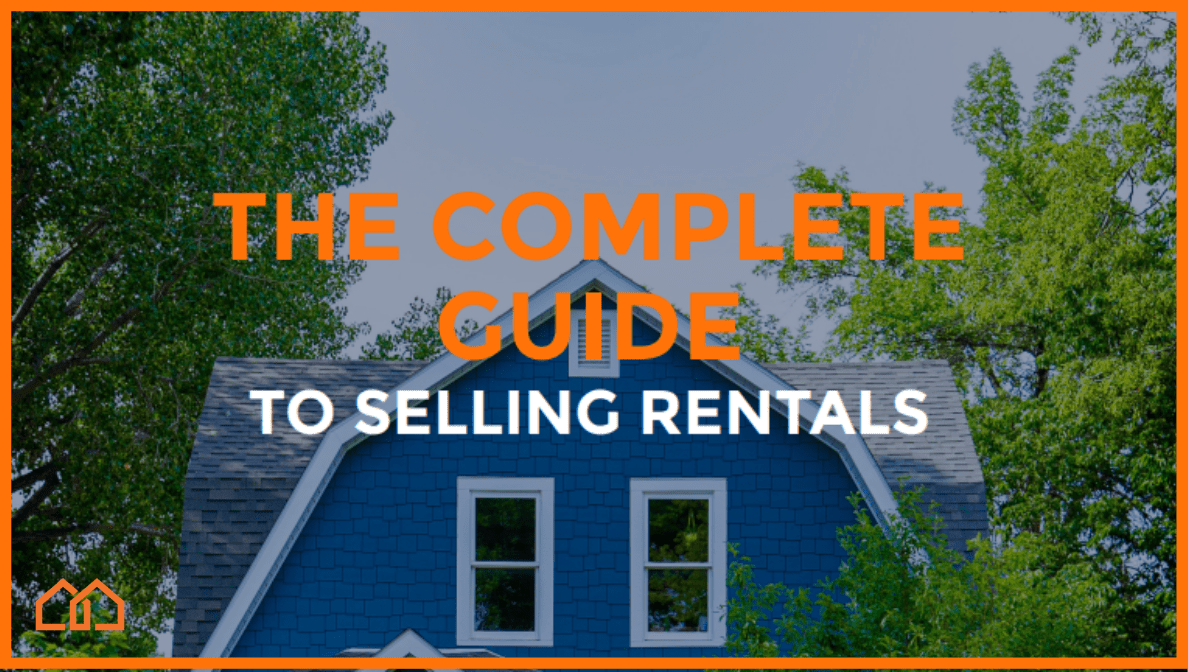Introduction
Investing in real estate is one of the most reliable ways people can generate income and establish a legacy. No two investor’s paths are the same, however. While one person may acquire a loved one’s estate and become an “accidental landlord,” another may own thousands of homes. This leads to each investor having a diverse set of needs – as well as experience level.
Every portfolio is unique with its own challenges and needs that require expert attention. The more specialists you bring into your fold to manage your portfolio, the better. While you have financial advisors to help you with the long-term picture of your investment journey, investment professionals are necessary for every stage of the portfolio development process: from acquisition to disposition.
Selling your rentals at the right time is an important part of the investment cycle. Not only does it help property owners make the most profit, it can also protect them against risk if an investment is no longer serving you.
A Whole New Set of Considerations
The process of selling a rental involves different considerations compared to selling an owner-occupied home. Firstly, rentals only generate income when they are occupied. Investors must be mindful of the advantages and risks of selling a rental while it’s occupied or unoccupied. Also, there is a vast difference between selling one or two homes at a time vs. a large portfolio.
This guide will help you follow the best practices of selling a rental property regardless of its condition, location, occupancy, or the scale of your disposition needs.
We’ll answer frequently asked questions regarding selling rentals, flesh out details, explain our investment disposition process, and discuss how Marketplace Homes is uniquely positioned to help investors get the most out of their ventures.
None of this would be possible without the valuable insights from experts and leaders in Marketplace Homes, including Mike Tamulevich, our COO, Andy Satkowiak our CRO, Troy Evans, Director of Investor Services, and Brad Borsos, Senior Management Consultant. Each leader mentioned is integral to the full functionality of our property management services and we are privileged to have them in our ranks.

Part 1: Frequently Asked Questions About Selling Rentals & Investment Properties
Q: What is the best way to sell my rental property?
There are a few ways you can sell a rental. What may be best option for one property may not be right for another. It all depends on the property’s unique characteristics. Here are the typical rental selling routes.
- You can sell it to an investor that can either fix and flip the home or take over an existing lease and immediately benefit from the cash flow.
- You can sell the home on the open market with the provision that the house is an occupied rental.
- You may request a cash offer on the house for fast and easy disposition.
- In some cases, the renter resident may be interested in buying the home.
“If we’re going to quietly market something to other investors and we are 100% sure they will hold the rental, we don’t inform the resident until some sort of activity needs to happen in the home, like an inspection. As soon as we know the timeline, we inform the tenant of the situation and when to expect the inspection,” says Mike.
In this whole process, Marketplace Homes provides investors different options and guides you through the pros and cons. The best choice for you is usually based on the condition of the home, your timeline, and the type of tenant you have.
“The kind of relationship with a tenant makes a big difference because we are counting on them to open up their schedule to make showings happen,” says Brad.
Q: When do I Inform my tenants that I am selling?
Speaking of tenants, it’s important to let them know your intention when the sale is set in stone. There is no reason to inform a tenant when nothing is certain since it can cause unnecessary concern. The timing when you inform tenants also depends on whether you decide to market the property on the open market or quietly sell to a network of investors.
If you choose to simply transfer the property to another investor, there will be little to no interruptions. An open market sale will involve more cooperation with the tenant if you choose to sell an occupied property, while an off-market deal involves little disruption on the renter’s end.
“The first thing we do is let the tenant know about the owner’s intention so that they can know exactly what to expect. If there is an effective lease on the property, it supersedes any ownership. Therefore, if there is an active lease, the tenant is within their rights to stay in the home regardless of who owns it. A lot of people think that when ownership changes, the lease doesn’t apply – but it still does. Once the owner decides to sell with a resident in place, we will inform the client before we actively market the property. After all, it’s no fun to see the home you live in listed for sale on Zillow!” says Mike T.
Q: What Are Tenant Rights for Sales and Showings?
To ensure that everyone is on the same page, it’s important to observe the tenants’ rights within the lease contract terms. Overall, nothing should change for the tenant regarding their lease. They still have full rights to the home and can’t get their lease terminated.
“The majority of leases will state that the owner/manager only has to give 24 hours advance notice to tour the property or conduct an inspection. This doesn’t happen that often though. We strongly advise our owner-clients that if they are to widely market their property, part of the plan should be to have no showings until an executed purchase agreement is in place,” says Mike T.
Thankfully, other investors that buy rental homes usually make their decision by looking at photos and running the property’s numbers. They don’t need to walk in because they won’t live there. After the purchase agreement is in effect, the buyer can get an inspection of the property. That acts as “the showing/inspection” and is the most convenient option when there is a resident in place and their intent is to continue renting.
If showings must happen outside of the one showing/inspection visit, then it’s best to speak to the tenant and gather the best times and days of the week for showings.
“We want the residents to be happy. Nobody wants 20 showings on a Sunday. Though they legally don’t have a right to decline the showing, it can make the resident relationship strained. We heavily advise against inconveniencing the tenant,” says Mike.

Q: How Do You Do Showings with a Tenant in The House?
Ideally, it’s easier to sell a home without a tenant in it, but many investors can’t wait for a lease to end. If you need to sell mid-lease, it’s important to ensure that the tenant is as comfortable as possible.
“Having the home occupied makes a big difference. If someone is going to purchase the home, they will need to go there at least once. This is a double-edged sword because often occupied homes are not shown in the best light since renters are not motivated to make the house show well. While this option eliminates vacancies, showing the home while tenant-occupied can make the home seem less valuable,” says Brad.
Therefore, the best practice is to not do any showings with a tenant in a rental house. But if you must do a showing, be as courteous and considerate as possible. Understand that the occupant is not a motivated seller. Renters gain nothing from the process and are in fact negatively impacted by showings and other interruptions.
Q: What Are the Best Practices for Showing Occupied Rentals?
Showing an occupied rental is something we strongly advise against. However, if you must, here are the best practices to get it done.
- Let the resident know as far in advance as possible about your plans.
- Plan all showings according to the tenant’s showing guidelines in the lease agreement.
- Collect a schedule of preferred times and days for showings.
- Be courteous and make the showing as unobtrusive as possible.
- Offer a solution for showing obstacles like pets or small children. A gift card to a theme park, indoor bounce park, or dog daycare can help greatly.
- If the owner doesn’t have practical impediments, you can still offer a treat like a gift card to a local coffee shop to help them pass the time.
- Keep the showings as short and thorough as possible. Consolidate showings, if possible, to prevent more interruptions.
Q: How Do You Market an Occupied Rental?
Marketing an occupied rental is different from marketing an occupied resale home. While there are fewer opportunities to take photos and make repairs, you also have other resources up your sleeve to help. Everything works out when you get the property in front of the right buyers though.
- Photos and Staging: It is challenging to stage an occupied rental and take photos due to the risk of inconveniencing the tenant. Often, it is easier to use photos that were taken while the home was between leases and emptied, cleaned, and prepped for the next tenant. Virtual staging helps a ton in this regard since you can put furniture into these images of empty rooms.
- Exterior and Interior Work: Working on curb appeal is much easier to accomplish. Power washing the house and doing general landscaping can happen without too much intrusion. Maintenance should be ongoing with a tenant in place too, but if major replacements like a new HVAC or roof need to be installed, the tenant needs to be informed as soon as possible – or a credit can be given to the buyer to be rectified after the sale.
“When it comes to marketing an occupied rental, there are 100 ways to do it,” says Mike T, “You can put it on the market with instructions for no showings. You can also treat it more like a pocket listing and share it with interested buyers instead of broadcasting it widely. In this case, we have a built-in-clientele that is always looking to purchase. We cross reference the portfolio’s data with features and locations and share it with the investors who would be the most interested. It works really well.”
We change our plan depending on your portfolio’s unique needs.
Marketing tactics change depending on whether the client is an owner of a single home or a large portfolio. Individual homes are often sold like the typical single listing. Meanwhile, institutional investors with many homes to sell at once require a team of people working on their inventory to decide a strategy for each unit. Marketplace Homes does this work, including the underwriting.
“For marketing a rental, there is not one set method. What condition is the home in? Will we be in a position to show with the tenant or not? If we think that there will be issues with the home then the best route is to wait. Much depends on the owner’s situation and how they feel the tenant has treated the property. All things combine to bring in the top dollar,” says Brad.
Each investment is unique enough that you shouldn’t use the same strategy for an entire portfolio. Marketplace Homes is an expert at helping investors find the best route for each investment to help clients get the most out of the sale- whether it’s to make profit or cut losses and minimize any negative impact as much as possible.
“Our clients are counting on us for guidance and to share the pros and cons of each scenario. Through these expert insights, we can guide them to the right solution,” says Brad.
Q: How to Get Top Dollar for Selling Investments
While investors who want to sell usually want to list right away, the whole point of an investment is to make money. By examining each possible solution, they can decide on the most profitable option, whether it’s selling on the open market, making it a pocket listing and selling to other investors, or selling it to the renter-occupant directly.
Selling on the open market can give you top dollar, but that depends on if the home shows well. You can also skip the standard marketing and sell your portfolio to another investor. If the house won’t show well with the tenant in place, you will likely sell at a discount on the open market. Conversely, this same property can show well if you wait until the end of the lease and do standard marketing. Depending on the condition of your investments, there will be advantages and disadvantages to either method.
The right answer depends on the market.
“The market is cyclical where we have ebbs and flows. You never know when it is the perfect time. 5-10 years ago, selling with a resident in place as associated with an implied 8-10% discount. Two years ago, landlords got premiums for having residents in place. In 2023, we are back to where there is an implied discount with selling an occupied rental. Right now, to get more money, you should vacate the property, do the renovations, then sell to an investor or an owner-occupant. After figuring in the lost rent, you’re pretty close to getting top dollar,” says Mike.
As you can see, the right solution can change depending on the market. Speaking with a real estate professional is your best bet for getting top dollar.

Q: How to sell more than one property at a time?
Selling more than one property at a time is a feat that not every brokerage can do well. To be positioned to help investors sell more than one property at a time, you need teams of experts and to have connections with other investors. The more you sell at once, the more support you need.
“By dividing our company into teams, we put talented people in their specific area of expertise. So, for each stage of the selling process, you are working with an expert instead of a jack of all trades,” says Brad Borsos.
Selling More Than 5 Properties at a Time
“We are no strangers to selling many properties at once. We have helped people with large, highly-valued portfolios in the millions as well as people with 2-3 properties. For all our clients, we work with them to develop a strategy to maximize return on each property. For big portfolios, we break it down line by line to determine which properties should be sold as a rental or resale home,” says Mike.
By sorting each home, our disposition experts decide the best strategy for each home. The list gets divided into what should be sold as an occupied rental to another investor, what should be vacated and sold to an owner occupant, among other options. By doing that analysis with fully integrated acquisition and disposition teams, the investor gets a proposed strategy for maximum profit.
“With significant investors in our network, we adjust the strategy according to market conditions. We can analyze a portfolio and break it into segments to maximize returns,”says Mike.
Selling less than 5 properties at a time
When it comes to selling small portfolios, Brad Borsos has plenty of experience. Smaller groups of homes are better off when treated like individual listings. Just like with a larger portfolio, our teams run the numbers, assess the property’s unique condition, tenant quality, and market.
“Let’s say we have a client who needs to sell three rentals. First, we gather information on the properties. I run a comparative market analysis for each home to see their potential sale prices, grabbing comps to back up the numbers. After showing the client the full analysis, I get them on board and send over listing agreements. Before they sign, I explain the sales process, commission, and other things to expect like inspections. After the listing agreement is signed, our marketing concierge team calls them to get information to write a listing description and get it on the MLS. If it’s occupied, we can stage vacant property photos with virtual staging. When the property is up and live, the listing agent takes over and updates the client as needed with feedback and updates,” says Brad.
For smaller batches, entrusting them to a listing agent offers a quality, personal approach. But unlike standard solo agents, Marketplace Homes listing agents are supported by our marketing, accounting, acquisition, disposition, renovation, and property management teams. In this way, they just get to focus on selling homes instead of tending to admin work, finances, or service issues.
Q: Is It Just Better to Sell Without a Tenant in The House?
The best option is all relative to what you need and what you can monetarily handle. Logistically, it’s far easier to sell a vacant property. However, this option may not be in line with your timeline, and that’s okay too. In the end, the numbers even out if you can sell higher when the property is vacant and marketed to show well.
Showing when the tenant is in the property can have mixed results because of unexpected smells, lower level of tidiness, potential clutter, and overall “lived in” look that may not let the house shine.
“Showing a vacant house gives you a better leasing experience because it enables you to charge more rent compared to when someone saw the property filled with someone else’s belongings,” says Andy.
Logistically, it is easier to sell without a tenant, but you must figure in the other side of the equation: no income from the rental. However, what you gain from that time is the ability to do more serious renovations, deep clean, virtually stage the property, schedule showings at any time of day, etc.
“If there is a resident issue, then sell after they move out. If they are going to be difficult, why do it? The best route is to wait for them to vacate,” says Troy.
It’s up to your preferences, finances, and your timeline. If you can put the work into each unit and can sacrifice a month or two of non-payment of rent, then waiting until after the lease ends is also an acceptable option.
If speed is what you need to fund a profitable new investment, then selling a lot of properties at the same time to an investor in the Marketplace Homes network can also be the best option.
Q: How Do You Help Accidental Landlords?
Marketplace Homes started out by helping accidental landlords, so this is one of the best places for investors to sell a property they never expected to own. As the name implies, accidental landlords acquire a property unintentionally. Often, this happens through inheriting a loved one’s estate, which means that these properties bear a lot of emotional weight. They also usually aren’t career investors and need more support than the typical investor.
“With our years of experience helping accidental landlords, we are in a good position to assist people who haven’t been through the selling process as often as other investors. These property owners are looking for more personal guidance compared to an investor with over 100 homes. Our service to accidental landlords also keeps in mind their personal attachment to the property, and so we handle it with care,” says Brad.
Accidental Landlords
For accidental landlords, finding a profitable solution, or one that at least cuts losses, is paramount. Leaving the home to decay is a waste as even a distressed home can be turned into a sale to the right buyer. When renovations aren’t worth the upkeep, selling to a house flipper can be the smartest move, saving the accidental landlord a headache. If the house is already occupied with a tenant, it’s also possible to sell it to another investor even if they are in the middle of the lease.
If the home is in fair to good condition, fixing it up and handing responsibilities over to a property manager can keep the house in the owner’s name and have it generate income that can grow over time. Selling on the open market is also a viable choice. A seasoned real estate professional can advise the accidental landlord on the right path according to their financial needs, comfort level, and preferences.
“Knowing your customers and understanding what their real goal is for the property helps you get the house in the right hands. When the accidental landlord works with us and the new landlord stays in house with us, the process is smooth, and nothing really changes just the owner. We also do assumptions from other property management companies too,” says Mike.
Q: What if your client is selling a portfolio managed by a different property management company?
If a client wants to sell properties in a portfolio that is managed by a different property management company, we can certainly help. In this situation, Marketplace Homes honors the terms of the existing lease because they legally can’t be changed. The tenant has nothing to worry about and we go on with the process of selling properties as usual.
“When we take over homes, we ask for the lease so we can honor its terms and agreements. We will then get residents’ contact info and ledger to know where they stand and understand our next steps. We then onboard them to the next steps, send them a copy of their lease and inform them that we have the same copy and that we will honor its terms and pass it on to the new owner after the sale,” says Troy.
Overall, the extra step required in selling a portfolio managed by another company is getting to know the properties’ history. We need to access the data and not make any assumptions about its condition. If the new owner of the properties wants to choose us as the new property management company, that certainly streamlines future operations because we will have all the information in one place.

Part 2: The Marketplace Homes Process for Selling Rentals
Understanding the common pain points and resolutions with selling investments, Marketplace Homes has established a turnkey process to sell rentals of all sizes, ages, lease stages, locations, and other conditions. Here is the process that our teams go through to market, show, and sell rental portfolios of all scales.
Step 1: Gather information.
Knowing as much as you can about the client’s needs is the basic first step every real estate professional needs to take to do a good job. Gather all relevant information like:
- Is the property occupied or vacant?
- What is the property’s condition?
- If occupied, when is the lease ending?
- Is the tenant cooperative or not?
- What are the property’s comps like?
- How is the property’s market faring right now?
- If you plan to sell to an investor, what is the property’s potential cap rate, etc.?
Understanding the property will enable you to make a tailored plan. No two properties have the exact same needs, so setting this foundation will be the key to following the next steps correctly.
“The first step to this would be to look at the property now. Is it a good investment or are you selling it because you’re having issues with residents or just because it is time to sell it? Find out the reason behind selling it – that will be your guide,” says Troy.
Step 2: Understand How to Position the Property on The Market.
When you have all the information you need about the property, you can then make a plan to sell it. Every property has its ideal buyer, regardless of the market. The key is to position it correctly so that it gets sold.
“Do you have a high-end portfolio, a dense one with houses in all one place, a scattered one with properties in different markets, fixer uppers or new homes? Regardless of what you have, here is an optimal way to position each listing on the market. Understanding what you’re working with helps you put it in front of the right people and market to them effectively,” says Andy.
For example, occupied properties can be advantageous for investors. They don’t mind combining the home inspection and showing into one session and can often make a decision to buy from looking at photos and move-in inspection reports. They don’t mind taking over the occupied home because that’s instant cash flow too.
Our acquisitions and sales team is responsible for running the numbers on portfolios to get them in front of investors. After rigorous training, they are experts at targeting listings in front of the right buyers. They work with investors across the country with each property sale handed on a case-by-case basis.
Step 3: Notify Tenants (if applicable).
If the residence is occupied, then it’s advised to inform the tenants about the process only when necessary. If there is a new investor buyer, it’s important that they don’t communicate with the resident at all until they buy the house. Everything goes through the seller and their agent to keep things streamlined.
Step 4: Market the Property.
Whether you decide to sell on the open market or to an investor, there may be some degree of preparation required …. or not when it comes to a buyout!
“We take all the information into account to know how to market. Our marketing concierge team takes care of this process. I would prefer our marketing concierge and our property listing process over any team in the country.” says Andy.
The Marketing Concierge team is fully in charge during this stage. They get the best local photographers on assignment, process and post the photos. This means they don’t just upload photos, but make them look sharper and brighter to help each home show better. We also do virtual staging with neutral and desirable room aesthetics to help more people view them as being able to live or own the property.
Step 5: Sell the Property.
The next step also looks different depending on whether we treat the listing as an open market sale or a pocket listing for investors.
Open market sales are easier for a small batch of homes. Large batches can be sold to our private investor network, but we can also sell single homes in this way too. We have buyers who are happy to pick up homes one at a time. An investor network is absolutely necessary to sell a portfolio.
“The open market is standard for more than one property for sale. We can also do buyouts; we can run numbers and take it off their hands. We can also buy and hold ourselves. For an accidental landlord that wants hands off, a flip fund, we have many options,” says Brad.
Marketplace Homes take a different approach based on the scale of the portfolio. The plan changes depending on if you’re an accidental landlord or an owner of more than 100 properties. Essentially, we address each situation based on whether they are individual or bulk deals.
For Large Portfolios:
“Selling a lot of homes simply takes more time. Each house needs to be evaluated and inspected. If the buyer is another investor, they may not look at all the houses personally. Instead, they can look at photographs of the rental and check its maintenance history to get an idea of where it stands. The buyer can also select which properties that they want an inspection for. Overall, if any property doesn’t have maintenance history, we advise them to proceed with caution,” says Troy.
With large portfolio disbursements and situations when we assume active leases, the sales agreements are a lot more complicated. These custom purchase agreements involved attorneys coming back and forth conducting negotiations on the agreement. The one thing on anyone buying a portfolio or one off to make sure they get all the property’s information upfront to work in tandem with the seller.

Part 3: The Marketplace Homes Difference
What sets us apart from a standard brokerage regarding investment disposition? Apparently, a lot. There are not many services like us, and investors often have to go several places to get the all-inclusive package that we offer.
We’re Nationwide
Marketplace Homes operates in varied markets nationwide, making it one of the few hybrid brokerage and property management companies that can help investors with both scattered or dense portfolios. Our experts focus on the unique details of every market to operate efficiently, with processes scaled across 25+ states.
This makes it easier to diversify portfolios for investors who want to minimize risk. We can help clients sell accidental landlord properties in different states and launch new investors on an exciting journey by widening their investment property options.
If you choose to turn your property into a rental, we can handle it even if it’s not in your state. We don’t favor any markets, since we’re nationwide. Since we are not limited by the geography in which we operate, investors get unbiased advice.
“If you’re an investor in Atlanta, and you’re working with a realtor in that market, they will tell you why Atlanta is great. But if you talk to us, we will talk to you about whether Atlanta is good for YOU or not. We are not biased toward any market because we don’t have an affinity to the location. We will only recommend the type of property and market that is the best for your portfolio,” says Mike.
We Do Everything in One Place
We don’t just help you find or sell your portfolio, but we can also MANAGE your property, a big differentiator that a lot of brokers can do.” – Andy Satkowiak, CRO of Marketplace Homes
Marketplace ONE, which launched in Summer 2023, is a full-cycle property management service where we acquire, fund, manage, maintain, and sell investments under one roof. In short, it is the total ecosystem for customers to use in real estate investing and growing/optimizing their portfolio.
The reason? We saw a need and filled it. Previously, there was no one-stop-place for any investor to have a completely integrated experience.
Specifically, Marketplace One includes these services:
- Sourcing homes using cutting edge technology.
- Team of experienced home buying professionals.
- Access to on and off-market properties.
- Funding through MINO for purchases, construction loans, and more.
- In-house title services which is faster and results in fewer headaches.
- Renovation work and rent-ready logistics.
- Best- in-class in marketing and showing homes.
- Leasing the homes – high volume leads, traffic, human led expertise.
- Active Management – Boots on the ground, team of specialists!
- Reporting via property management software with over 75 available reports and custom reporting options.
- In-house accounting and legal services.
Expert-Centered Approach
We have different specialty teams instead of one person handling it all, which makes us able to help our clients quickly and efficiently. When a client comes to us and needs help selling a rental property, we send them to our expert teams one at a time.
- Solutions Team
- Examines your portfolio and creates a plan specific to your situation.
- Can arrange cash offers, pass properties on to marketing or acquisition/dispositions.
- Acquisitions/ Dispositions Team.
- Comparative market analysis.
- Find the best plan for each property.
- Execute the best plan to buy or sell a home.
- Marketing Concierge.
- Photographers.
- Property descriptions.
- Listing Agents.
- Property Management Team.
- Renovations Team.
Remote Technology
To operate across state lines, information needs to be securely kept and accurately retrieved through streamlined systems. We use robust property management and bookkeeping software to keep track of everything, making things more convenient for all parties. Examples of tech we use:
- Remote home staging through virtual technology
- Remote showings through coded lockboxes
- Property management software with customizable asset management platform
- Revela: An out-of-the-box software that we can customize and build on to meet client needs.
- CompanyCam for remote monitoring and real-time reporting of renovation progress.
Boots on The Ground
Along with remote management, we also have local pros that we trust in each market that act as boots on the ground.
- Photographers that can virtually stage and digitally enhance photos for maximum marketability.
- Property management across state lines
- Home Inspectors.
- General contractors for renovations and house flipping.
- Quality control specialists in select markets.
Common Sense Cash Offers
When a client needs to sell quickly, we offer convenient cash offers that are honest about concessions and fees from the get-go. Unlike other iBuyers that make an unrealistically high offer then tack fees and concessions at the end post inspection, we offer a fair and accurate offer based on the property’s market value and condition.
Since we only use technology to run numbers and then use common sense to name our price, our buyouts are done with the most common sense and transparency compared to our competitors.
Holistic Approach
We are more than just a brokerage. While other companies may have one or two solutions, Marketplace offers a variety of choices for investors to sell their investments in the most strategic way.
“We are a solutions-centric company and don’t go in with just one solution. There may not be one best play to sell a portfolio of homes, so we often offer several paths a client can take, or they may take two solutions simultaneously,” says Troy.
Mike, our COO, also takes pride in how Marketplace stands out in how it approaches selling investments. “We take a holistic approach to every situation. We are not coming and prescribing the same thing, diagnosing the same remedy. Instead, we examine each situation as an individual and prescribe a solution (or set of solutions) that work uniquely for our clients.”
Closing Remarks
Selling an investment, whether it’s one property or a large portfolio of rentals, is a process that every investor should navigate carefully. By working with a brokerage that knows industry specifics about investment dispositions, you can get the best strategies to sell compared to ordinary real estate agencies.
Marketplace Homes has a rare abundance of options for investors who want to sell their rentals. From quick and honest cash offers to listing single properties on the open market, our organized teams of real estate experts will guide you every step of the way.
Alicia Persson is a Content Strategist SEO writer at Marketplace Homes, utilizing previous years of experience on real estate teams that specialized in investments and property management. Before she joined Marketplace Homes, she was also a freelance writer for 7 years, leading to a specialization in real estate and home living content for boutique digital marketing agencies. During her writing years, she learned the basics of SEO and gained experience writing for many different clients, making her versatile at creating diverse content.
She is a proud University of Virginia master’s graduate and enjoyed her undergraduate years at the University of Mary Washington. When Alicia is not writing, she plays keytar and sings in a local 90’s rock cover band, or she spends time with her amazing family.


